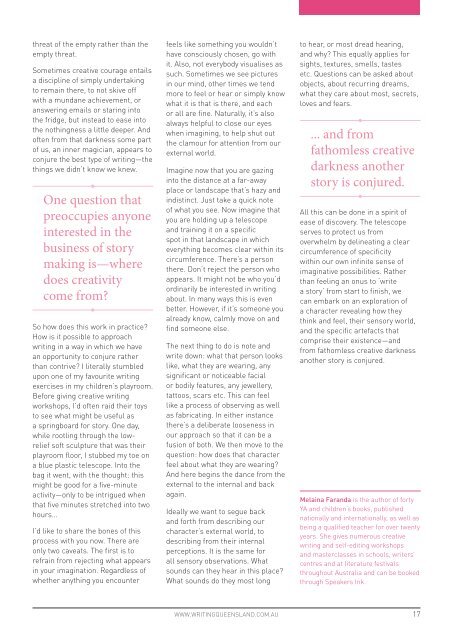Kristina Olsson
?r=MTAwMA0KDQoNCmM2ZDAwMDAwMDAwNjYwOQ0KaHR0cDovL3d3dy5xd2MuYXNuLmF1L2Fzc2V0cy9maWxlcy9XUU1hZ2F6aW5lL1dRJTIwSXNzdWUlMjAyNTUlMjAtJTIwZmluYWwucGRmDQp0cnVlDQptZWxpc3NhY3JhaWdhdXRob3JAZ21haWwuY29t
?r=MTAwMA0KDQoNCmM2ZDAwMDAwMDAwNjYwOQ0KaHR0cDovL3d3dy5xd2MuYXNuLmF1L2Fzc2V0cy9maWxlcy9XUU1hZ2F6aW5lL1dRJTIwSXNzdWUlMjAyNTUlMjAtJTIwZmluYWwucGRmDQp0cnVlDQptZWxpc3NhY3JhaWdhdXRob3JAZ21haWwuY29t
You also want an ePaper? Increase the reach of your titles
YUMPU automatically turns print PDFs into web optimized ePapers that Google loves.
threat of the empty rather than the<br />
empty threat.<br />
Sometimes creative courage entails<br />
a discipline of simply undertaking<br />
to remain there, to not skive off<br />
with a mundane achievement, or<br />
answering emails or staring into<br />
the fridge, but instead to ease into<br />
the nothingness a little deeper. And<br />
often from that darkness some part<br />
of us, an inner magician, appears to<br />
conjure the best type of writing—the<br />
things we didn’t know we knew.<br />
One question that<br />
preoccupies anyone<br />
interested in the<br />
business of story<br />
making is—where<br />
does creativity<br />
come from?<br />
So how does this work in practice?<br />
How is it possible to approach<br />
writing in a way in which we have<br />
an opportunity to conjure rather<br />
than contrive? I literally stumbled<br />
upon one of my favourite writing<br />
exercises in my children’s playroom.<br />
Before giving creative writing<br />
workshops, I’d often raid their toys<br />
to see what might be useful as<br />
a springboard for story. One day,<br />
while rootling through the lowrelief<br />
soft sculpture that was their<br />
playroom floor, I stubbed my toe on<br />
a blue plastic telescope. Into the<br />
bag it went, with the thought: this<br />
might be good for a five-minute<br />
activity—only to be intrigued when<br />
that five minutes stretched into two<br />
hours…<br />
I’d like to share the bones of this<br />
process with you now. There are<br />
only two caveats. The first is to<br />
refrain from rejecting what appears<br />
in your imagination. Regardless of<br />
whether anything you encounter<br />
feels like something you wouldn’t<br />
have consciously chosen, go with<br />
it. Also, not everybody visualises as<br />
such. Sometimes we see pictures<br />
in our mind, other times we tend<br />
more to feel or hear or simply know<br />
what it is that is there, and each<br />
or all are fine. Naturally, it’s also<br />
always helpful to close our eyes<br />
when imagining, to help shut out<br />
the clamour for attention from our<br />
external world.<br />
Imagine now that you are gazing<br />
into the distance at a far-away<br />
place or landscape that’s hazy and<br />
indistinct. Just take a quick note<br />
of what you see. Now imagine that<br />
you are holding up a telescope<br />
and training it on a specific<br />
spot in that landscape in which<br />
everything becomes clear within its<br />
circumference. There’s a person<br />
there. Don’t reject the person who<br />
appears. It might not be who you’d<br />
ordinarily be interested in writing<br />
about. In many ways this is even<br />
better. However, if it’s someone you<br />
already know, calmly move on and<br />
find someone else.<br />
The next thing to do is note and<br />
write down: what that person looks<br />
like, what they are wearing, any<br />
significant or noticeable facial<br />
or bodily features, any jewellery,<br />
tattoos, scars etc. This can feel<br />
like a process of observing as well<br />
as fabricating. In either instance<br />
there’s a deliberate looseness in<br />
our approach so that it can be a<br />
fusion of both. We then move to the<br />
question: how does that character<br />
feel about what they are wearing?<br />
And here begins the dance from the<br />
external to the internal and back<br />
again.<br />
Ideally we want to segue back<br />
and forth from describing our<br />
character’s external world, to<br />
describing from their internal<br />
perceptions. It is the same for<br />
all sensory observations. What<br />
sounds can they hear in this place?<br />
What sounds do they most long<br />
to hear, or most dread hearing,<br />
and why? This equally applies for<br />
sights, textures, smells, tastes<br />
etc. Questions can be asked about<br />
objects, about recurring dreams,<br />
what they care about most, secrets,<br />
loves and fears.<br />
... and from<br />
fathomless creative<br />
darkness another<br />
story is conjured.<br />
All this can be done in a spirit of<br />
ease of discovery. The telescope<br />
serves to protect us from<br />
overwhelm by delineating a clear<br />
circumference of specificity<br />
within our own infinite sense of<br />
imaginative possibilities. Rather<br />
than feeling an onus to ‘write<br />
a story’ from start to finish, we<br />
can embark on an exploration of<br />
a character revealing how they<br />
think and feel, their sensory world,<br />
and the specific artefacts that<br />
comprise their existence—and<br />
from fathomless creative darkness<br />
another story is conjured.<br />
Melaina Faranda is the author of forty<br />
YA and children’s books, published<br />
nationally and internationally, as well as<br />
being a qualified teacher for over twenty<br />
years. She gives numerous creative<br />
writing and self-editing workshops<br />
and masterclasses in schools, writers’<br />
centres and at literature festivals<br />
throughout Australia and can be booked<br />
through Speakers Ink.<br />
WWW.WRITINGQUEENSLAND.COM.AU 17


